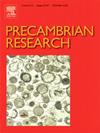Retreating subduction-related intracratonic rifting in the Ediacaran Sichuan Basin (SW China)
IF 3.2
2区 地球科学
Q2 GEOSCIENCES, MULTIDISCIPLINARY
引用次数: 0
Abstract
Ediacaran continental rift basins in the Sichuan Basin (SW China) overlap in time with the breakup of Rodinia and the assembly of Gondwana, but whether the rifts occurred in response to a mantle plume or to a subduction-related mechanism at the outer margin of the supercontinent remains uncertain. In the absence of Ediacaran igneous rocks, we provide zircon LA-ICP-MS U-Pb age data and whole-rock geochemistry from exposed Ediacaran-Lower Cambrian siliciclastic rocks in the Sichuan Basin in an effort to decipher the origin of the Ediacaran rifting. Together with new seismic and drilling data, the Ediacaran period is characterized by a magma-poor rift succession deposited in a faulted depression within the basin. U-Pb ages of the Ediacaran detrital zircons are concentrated in the range of 850–630 Ma, which suggests a weak magmatic event during the Ediacaran rifting. Geochemically, the siliciclastic rocks are characterized by relatively flat rare earth elements (REE) with negative Eu* anomalies, enrichment in most high field strength elements (HFSE), but depletion in Nb, Ta, Sr and Ti. The geochemical data suggest that the Ediacaran sedimentary rocks formed in a continental island arc setting. Together with compiled zircon εHf(t) values, Ediacaran rifting in the Sichuan Basin is consistent with retreating subduction. We propose a weak, flat, retreating subduction-related intracontinental passive rift model for the Ediacaran South China Block. This case study suggests that the retreating subduction could not only trigger back-arc basin development, but could also lead to the magma-poor passive rift basin.
埃迪卡拉纪四川盆地(中国西南部)与俯冲有关的地壳内断裂正在消退
四川盆地(中国西南部)的埃迪卡拉纪大陆裂谷与罗迪尼亚的解体和冈瓦纳的形成在时间上重叠,但裂谷的发生是由于地幔羽流还是超大陆外缘与俯冲有关的机制仍不确定。在缺乏埃迪卡拉纪火成岩的情况下,我们提供了四川盆地出露的埃迪卡拉纪-下寒武纪硅质碎屑岩的锆石LA-ICP-MS U-Pb年龄数据和全岩地球化学数据,试图破解埃迪卡拉纪断裂的起源。结合新的地震和钻探数据,埃迪卡拉纪的特征是在盆地内的断层凹陷中沉积了岩浆贫乏的裂谷演替。埃迪卡拉纪碎屑锆石的 U-Pb 年龄集中在 850-630 Ma 之间,这表明埃迪卡拉纪断裂期间发生过一次微弱的岩浆活动。从地球化学角度看,硅质碎屑岩的稀土元素(REE)相对平坦,Eu*呈负异常,富含大多数高场强元素(HFSE),但Nb、Ta、Sr和Ti元素贫乏。地球化学数据表明,埃迪卡拉纪沉积岩形成于大陆岛弧环境中。结合已编制的锆石εHf(t)值,四川盆地埃迪卡拉纪的断裂与后退俯冲是一致的。我们为埃迪卡拉纪华南地块提出了一个弱的、平坦的、与后退俯冲相关的大陆内被动裂谷模型。这一案例研究表明,后退俯冲不仅可能引发弧后盆地发育,而且可能导致岩浆贫乏的被动裂谷盆地。
本文章由计算机程序翻译,如有差异,请以英文原文为准。
求助全文
约1分钟内获得全文
求助全文
来源期刊

Precambrian Research
地学-地球科学综合
CiteScore
7.20
自引率
28.90%
发文量
325
审稿时长
12 months
期刊介绍:
Precambrian Research publishes studies on all aspects of the early stages of the composition, structure and evolution of the Earth and its planetary neighbours. With a focus on process-oriented and comparative studies, it covers, but is not restricted to, subjects such as:
(1) Chemical, biological, biochemical and cosmochemical evolution; the origin of life; the evolution of the oceans and atmosphere; the early fossil record; palaeobiology;
(2) Geochronology and isotope and elemental geochemistry;
(3) Precambrian mineral deposits;
(4) Geophysical aspects of the early Earth and Precambrian terrains;
(5) Nature, formation and evolution of the Precambrian lithosphere and mantle including magmatic, depositional, metamorphic and tectonic processes.
In addition, the editors particularly welcome integrated process-oriented studies that involve a combination of the above fields and comparative studies that demonstrate the effect of Precambrian evolution on Phanerozoic earth system processes.
Regional and localised studies of Precambrian phenomena are considered appropriate only when the detail and quality allow illustration of a wider process, or when significant gaps in basic knowledge of a particular area can be filled.
 求助内容:
求助内容: 应助结果提醒方式:
应助结果提醒方式:


